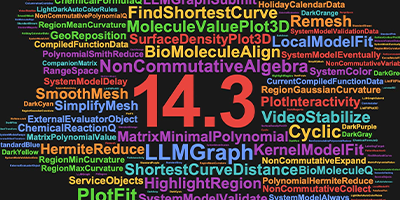Wolfram Year in Review: 2013
Before we dive completely into 2014, we’d like to take a minute to look back on some of the biggest announcements and most interesting stories that we shared on the Wolfram Blog this past year. Below are the top 10 most popular Wolfram Blog posts of 2013, with a few honorable mentions thrown in for good measure. Take a look—there are bound to be a few that you missed.
1. “Putting the Wolfram Language (and Mathematica) on Every Raspberry Pi”
The Raspberry Pi, for those who aren’t familiar, is a $25 computer used by millions for experimentation and learning how to code—and in November, we made Mathematica and the Wolfram Language available on the Raspberry Pi platform. It’s already being used for everything from creating weather stations to controlling sous vide cooking—and we’re excited to see where people take it next.
2. “Something Very Big Is Coming: Our Most Important Technology Project Yet”
In November, Stephen Wolfram announced a project to “make [sophisticated computation and knowledge] universally accessible to humans, programs and machines, in a way that lets all of them interact at a vastly richer and higher level than ever before”:
In a sense, the Wolfram Language has been incubating inside Mathematica for more than 25 years. It’s the language of Mathematica, and CDF—and the language used to implement Wolfram|Alpha. But now—considerably extended, and unified with the knowledgebase of Wolfram|Alpha—it’s about to emerge on its own, ready to be at the center of a remarkable constellation of new developments.
[…]
Just as the lines between data, content and code blur, so too will the lines between programming and mere input. Everything will become instantly programmable—by a very wide range of people, either by using the Wolfram Language directly, or by using free-form natural language.
3. “After 100 Years, Ramanujan Gap Filled”
In this post, Oleg Marichev and Michael Trott used Mathematica to explore a century-old mystery from the brilliant mathematician Srinivasa Ramanujan.
4. “A Visit to Disney’s Magic Kingdom”
How do you depict 75 years of Disney films in a single image?
In this composite color map, each row corresponds to a different Disney movie, with the dominant colors at different points of the movie changing as you go from left to right. Read about the role Mathematica played in developing Touch Press’ Disney Animated app (including this color map), which was recently named by Apple as the Best iPad App of 2013.
5. “Why Would a Mathematica User Care about R?”
Mathematica 9’s new RLink libraries provide integration and full access to the R statistical computing language from within Mathematica. As Jon McLoone pointed out, this gives Mathematica users not only new tools and functions, but also the chance to interact with and learn from the R community as a whole.
6. “Data Science of the Facebook World“
Using data generously donated by users of our Wolfram|Alpha Personal Analytics for Facebook program, we took a look at some interesting social and cultural trends, from the diversity of Facebook social networks…
…to how relationship statuses change by age:
7. “Is There Any Point to the 12 Times Table?”
As it turns out, not particularly—at least, when it comes to memorizing it in school. Jon McLoone explored the reasons for and against memorizing times tables past 10 in this fascinating post.
8. “Announcement: Our First CBM Country”
The Computer-Based Math™ initiative, supported by Wolfram Research, advocates building a completely new math curriculum with computer-based computation at its heart, while campaigning at all levels to redefine math education away from historical hand-calculating techniques and toward real-life problem-solving situations that drive high-concept math understanding and experience. Last spring, Conrad Wolfram announced that Estonia would become the first country to adopt CBM on a national level.
9. “Centennial of Markov Chains”
One hundred years ago in February, Andrey A. Markov presented the probabilistic state diagrams now known as Markov chains for the first time. Oleksandr Pavlyk used Mathematica to demonstrate the utility of Markov chains in text generation, linguistic analysis, and other fields.
10. “Exploding Art: da Vinci Code of Another Sort”
Vitaliy Kaurov turned images into 3D puzzles in this entertaining post. Give it a try!
Finally, there are a few posts that didn’t quite crack the top 10, but were still fascinating enough that we wanted to give them a mention:
- “Bringing Zombies to Life… Is That an Oxymoron?”
- “Visualizing Our Place in the Milky Way Galaxy with Mathematica”
- “Is High Debt Bad for Economic Growth?”
- “Random and Optimal Mathematica Walks on IMDb’s Top Films”
- “Q&A with Harvard Professor Oliver Knill” (AKA, the Miley Cyrus animation post)
Thanks to all our readers and Wolfram fans. Happy New Year, and keep reading for more exciting news in 2014!








Comments